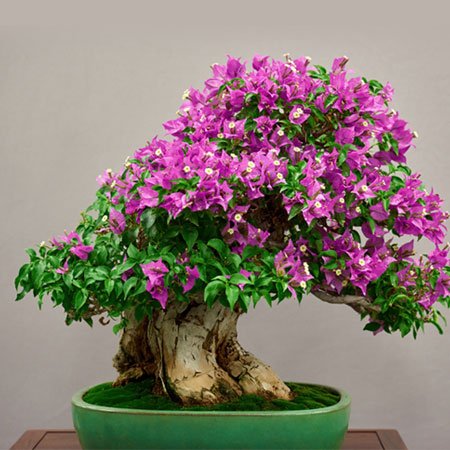Bonsai are shrubs or potted trees that are pruned to prevent their growth more than one meter. Though they look small, they resemble like the full-sized trees developing in a forest. It is interesting to note that a few varieties of bonsai trees live for more than a hundred years. Bonsai requires a great deal of maintenance to keep them in the best condition. If you are planning to grow a bonsai in your indoor or outdoor space, then this article is for you. Here you will learn all about bonsai, its types and care guidelines.
What is Bonsai?
Bonsai are basically plants and trees that are cultivated in containers that look prettier and beautiful than the ones that grows in the forest. It is an umbrella term used to represent several forms of potted plants. Bonsai refers to shrunk and contracted trees that are grown in a container.
They adhere to Japanese principles and tradition. It is perceived as an artistic hobby by not just Japanese but also by people all over the world. Growing these potted trees require a bigger emotional and physical commitment. The practice of cultivating Bonsai aims on long-term gardening and shaping of small trees budding in a container.
How It Got Originated?
Bonsai is an art form that has originated from East Asia. This practice uses cultivation methods to produce it in containers. Bonsai are small trees that imitates the form and size of full-size trees. The tradition of growing bonsai began from China and later influenced Japan and Korea.
It was originated in mid-fourteenth century. Bonsai became appreciated as artistic objects. People started to grow them as a hobby and an artistic pursuit. Bonsai was mostly enjoyed by high raking people in the society such as aristocrats, priests and more. A lot of books were published and large-scale exhibitions were held on the technique of growing bonsai.
What are the types of Bonsai?
Bonsai is basically a practice of taking regular-size trees, and miniaturize them to easily fit inside a container. Here is the list of bonsai tree types –
1. Japanese Maple
This is a highly adaptable form of outdoor bonsai tree. It is hard, and beautiful deciduous tree. This tree grows well in light sunshine, and shade. They can’t withstand midday heat. The Japanese maple requires leaf pruning every year to keep the size of its leaves small. It requires low amount of nitrogen dose as a fertilizer. You should water it well during the growth season.
2. Juniper
Juniper is one of the species of Bonsai that comes in over seventy different varieties. It is characterized by its elegant form, deadwood styling, and flexible growing habit. It is an evergreen shrub that is ideal for outdoor life. Just like other varieties of bonsai trees, you need to protect Juniper from extreme mid-day heat and frigid winter temperatures.
3. Pomegranate Tree
Among all the other varieties of bonsai trees, this is one of the most beautiful species of Bonsai. It is a deciduous semitropical tree that has striking visual contrasts. Its silvery bark, bright green colored leaves and dark red-orange fruits looks magical. This tree has got shallow root that makes it ideal for planting it in a container. Protect it from full sunlight. Bring it indoors to a light sunny spot to let it grow comfortably.
4. Indian Laurel Fig
This is another brilliant variety of bonsai that is ideal for beginners. Indian Laurel Fig is a wonderful indoor plant that requires bright, and indirect light. Sunlight or partial shade is ideal for its growth. This type of bonsai contains shallow trunk and root systems that can be twisted into several mesmerizing styles.
5. Beech Tree
This is a stunning bonsai tree that has got small leaves. People love it for its marvelous size that it gets with the onset of autumn color. The naturally small size of this tree makes it ideal for bonsai styling. The beech tree grows at a slow pace. It is fond of bright outdoor location. Beech tree prefers dry and moist soil, and no direct sunlight. You should bring it outdoors during freezing temperatures.
6. Boxwood
This is another good option for beginners who have no prior experience of growing a bonsai tree. A common boxwood bonsai is very convenient to care. It can easily adapt in varying environmental conditions but grows best in partial shade.
It can’t withstand extreme cold. The best type of soil for its growth is moist one but not soggy. You need to feed it with bonsai manure on a regular basis. Boxwood can’t withstand aggressive pruning. You can easily shape it with bonsai wire.
7. Rock Cotoneaster
If you have not grown bonsai earlier, and doing it for the first time, then Rock Cotoneaster would be the ideal bonsai for you. The distinctive part of this bonsai is its alluring leaf color that changes with the seasons.
You can find it changing from pretty white, to red, bright red, and pink. Rock Cotoneaster bonsai can be placed both in part shade, or full shade. However, you should protect it from extreme heat and frost. Dry soil is ideal for its growth.
8. Weeping Fig
This is a versatile variety of bonsai tree that grows well in indoors as well as outdoors. If you are intimidated by how to cultivate bonsai plants, then this could be the ideal learning example. The tree features tiny sized, and bright evergreen leaves that grows long with branches trailing to the ground.
Due to this reason, the tree has got the name, “weeping fig”. For the proper growth, this tree requires a minimum of six hours of sunlight every day. Its soil should be moist but not very wet. Its ability to easily recover from pruning mistakes makes it an excellent selection for bonsai beginners.
How To Grow A Bonsai?
So, once you have known the different types of bonsai, now it is the time to learn how to grow it. Below we have listed steps that will help you select the right bonsai and grow it in the best way.
1. Select the right Bonsai Tree
Based on your expertise, your location, and the climate of the place where you live, you need to choose a suitable type of bonsai tree. Some trees can’t withstand freezing weather, while others need the temperature to reach below the freezing point to come to a latent state and make themselves ready to bloom in the spring.
So, consider the climatic conditions before planning to grow a Bonsai, especially an outdoor one. You can take assistance of any professional gardener to guide you on choosing the right Bonsai tree. For beginners, slow growing Juniper should be the best option.
2. Choose between growing a Bonsai indoor or outdoor
This is another important step as the requirements of an outdoor and indoor Bonsai trees vary radically. Indoor environments are comparatively drier and obtain less sunlight when compared to outdoor environments. So, trees that require low moisture, and light would be ideal for indoor cultivation.
3. Choose the right size of Bonsai
Bonsai trees are available in various sizes. Larger bonsai require larger containers, and more water, sunlight, fertilizer etc. The smallest full-grown bonsai is six inches tall, and the large bonsai can be around three feet tall.
A few things that you need to consider when growing a bonsai are container size, available space and light at office, and very importantly, the amount of time, and energy that you can invest in taking care of your bonsai. This is very important because larger bonsai requires large amount of time to prune. So, keeping these factors in mind, you can choose the right size of bonsai.
4. Choose the right pot
The pot you use for growing bonsai trees also holds a lot of importance because it helps in restricting its growth. Ensure that the pot is sufficiently large to allow the soil to efficiently cover the plant roots. At the time of watering the tree, ensure that it soaks moisture from the soil and the roots of the tree are able to retain moisture.
This consideration will help in preventing the root of the tree from getting rotten. Ensure that the pot you select should have several drainage holes on its bottom. Your pot has to provide a neat, clean aesthetic for the bonsai tree.
Potting Grown Bonsai Trees
1. Prepare the tree
After buying it from the store, make sure that the tree is pruned to the desired shape. Gently clean its roots. Prune its roots before you pot it. Cut large, dense roots and upward-facing roots to prevent them outgrow your container. Let the web of slender, and long roots sits nearer to the surface of the soil. Wrap a strong wire around the branches of the tree to direct its growth.
2. Prepare the pot
Put fresh soil into the pot. It should reach the recommended height. Now at the bottom of the empty container, you should add one base layer of rough-grain soil. Now add a fine growing medium above it.
Choose the soil and the medium that provides good draining ability. Leave some space at the top of the pot to nicely cover the roots of the tree. Once you have prepared your pot in this way, you are now ready to transfer your tree into your prepared pot.
3. Pot the tree
Position the tree in your new pot in the desired orientation. Finish adding fine, and well-draining soil to the pot. Ensure that the roots of the tree are properly covered. If desired, you may add a final layer of moss or pebbles in it. In addition to being visually pleasing, this can help hold the tree in place. You may need to set up mesh screens on the drainage holes of the pot to protect it from soil corrosion.
How To Take The Best Care Of Your Bonsai Tree?
People are intimidated when it comes to taking care of bonsai. They find it is very hard procedure. But in reality, it is not that difficult that it looks. As these trees are grown in small-sized pots, they need a few basic rules should be followed to keep it in the best condition.
Bonsai Tree Care Guidelines for Newly Potted Trees
Your new bonsai could be delicate after when you have pot it. For two to three weeks, you should let it remain in a semi-shaded region. Safeguard it from the harsh weather, or direct sunlight. Keep watering the plant on a daily basis. Do not use fertilizer till its roots are properly re-established. Give your tree a good space to adapt it to the climate and thrive on its own.
1. Soil composition
Soil holds a very important place when it comes to the growth of bonsai. It supplies your tree with all the necessary nutrients. It should have the ability to drain properly and retain water. The soil you have composed has to be specialized to the requirements of each bonsai tree.
It should always be made up of a loose, and quick draining mixture of components. Either you can compose the soil on your own or get readymade soil for your specific Bonsai from online stores easily.
2. Light
Make sure that the sunlight is not too harsh so as to prevent it from dying. Also, the light intensity should not be too low as it could make the plant weak and hinder its growth. Ensure to place your pot at a bright spot.
3. Humidity
Make sure that the soil is adequately moist. This will help in raising it properly. If you have an indoor bonsai, chances are that the humidity levels will be low. You can mist your bonsai some times in a day to increase the humidity level.
4. Temperature
Tropical species of Bonsai require high temperatures all around the year than the standard room temperature. Subtropical trees have the ability to easily withstand lower temperatures, and thrive. So, ensure that you provide the desired temperature to your bonsai according to its species.
5. Location
Based on the time of year, indoor / outdoor bonsai and climatic conditions, you need to choose the ideal spot for your Bonsai.
6. Watering
Regular watering of bonsai is essential to ensure its sound growth. Based on the species of tree, size of pot, size of tree, soil-mixture, climate, and time of year, you need to figure out watering needs of your Bonsai.
7. Fertilizing Bonsai
Regular fertilization is needed to ensure the growth and survival of Bonsai. Normal trees have the ability to spread their roots in search for nutrients. Proper fertilization helps in restoring the nutritional content of the soil.
8. Pruning
Pruning of the branches of bonsai helps the tree to adjust its shape, maintain as well as enhance its beauty. It is the procedure that provides a better balance to the tree. Proper pruning promotes the healthy development of bonsai and helps it to receive adequate amounts of air, and sunlight. Based on the direction, length, and density of the branches, you can prune its branches using a scissor and a few more tools.
9. Wiring
Wiring is another method to give a pleasing shape to the bonsai. This procedure involves fixing wires to the branches, and trunk of the tree to form a desired curve. Generally, wires made up of copper, and aluminum in different thicknesses are used for this purpose.
These wires bring out the true “personality” and uniqueness of the tree without overpowering them. Based on the hardness, and size of the branch, you can make the right selection for your Bonsai.
10. Trim its leaves
To give the desired appearance to your tree, you need to selectively remove outgrown leaves from its branches, and trunk.
11. Clamping
Clamp your bonsai with the help of mechanical devices is another method that helps to shape its branches, and trunk.
Conclusion
Bonsai are very appealing. Cultivating these trees is a hobby enjoyed by a lot of people. It is considered to be a significant part of artistic, and cultural tradition of Japan that is cherished for several years by the affection of people and climate of the nation. The above information will help you choose the right species of bonsai and learn about specific care and maintenance guidelines to keep it in the best health.
If you liked this post, then do share it with your friends on social media. Also, you can write to us any of your queries, suggestions, and comments. We will be happy to address them soon.



